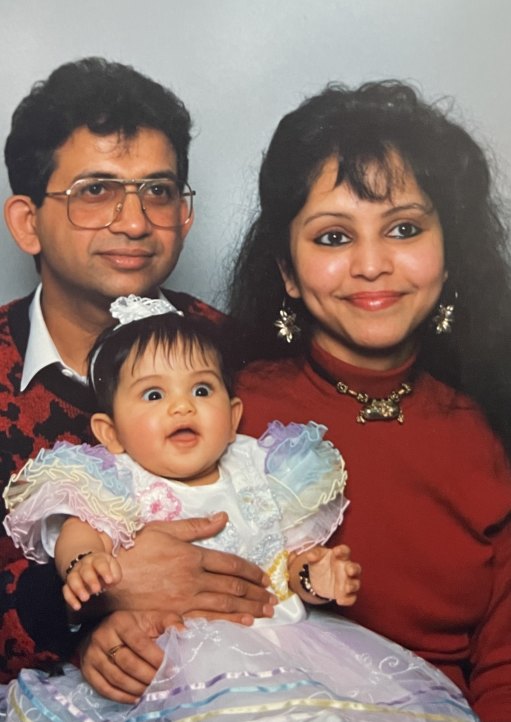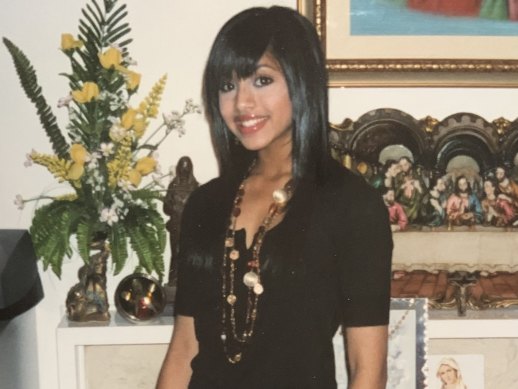I grew up in a big family of Indian immigrants who had moved to Australia yearning for adventure and a change of scenery. My folks immigrated in the early 1990s and settled in Melbourne alongside my mother’s siblings and their partners.
We lived in a humble three-bedroom home with shag-pile carpeting, wood panelling and counter tops that were whatever the colour is when you mix mustard with avocado green. To this day, the house still has the original icky brown-and-orange canvas sun blinds from the 1970s.
My parents embellished the 1970s design with Catholic paraphernalia and a lot of furniture in small spaces. And I remember every corner of that tiny home being filled with aunties, uncles and cousins, because there were impromptu family parties every weekend – informal social gatherings being a cultural norm. My mum always cooked extra food, anticipating unexpected guests, so our house was often filled with the rich aroma of biryani, dosa and saffron rice, signifying that food prepared with love was on the menu.
At these gatherings, Bollywood music blasted on the DVD player, competing with the sounds of laughter among uncles, the tinkling of aunties’ bangles and the voice of somebody’s parent rounding up the children to eat. There was the patter of little feet up and down corridors as my younger brother Dominic, cousins and I ran rampant, playing out our own games of “life”. Whether we were pretending to be shop owners, running a school, or trekking in a jungle, we always indulged our creativity.

Maria Thattil’s parents immigrated from India in the early 1990s and settled in Melbourne.
As the hands on the clock approached midnight, more and more relatives would filter out and head home, but my brother and I would conspire with our favourite cousins, usually the last to leave, and choreograph a dance to perform for our parents in a bid to get them to agree to a sleepover. We always put on a show, even though they never failed to say yes to the sleepover anyway.
Growing up, it felt like I wasn’t raised by two, but by many, experiencing my roots within the walls of my home through community, food, clothes, music, movies, the language my parents spoke and the values they imparted. But as early as my first years in school, I started to develop a sense of being “different”. In my first year, there was a little boy I fancied. He was Italian with gorgeous dark hair and eyes and a love of music; he was that boy all the girls had a crush on. I was the shy girl with a Dora the Explorer-esque fringe, ashy knees and an oversized school dress.
Too shy to relay my feelings to my crush myself, I asked one of my cousins to tell him I liked him and report back. I was anxiously waiting to hear his reply when my cousin returned, only to tell me that he replied in horror that there was no way he could like me, as I was a “monster” with “dirty skin”. Picturing myself as a small child trying to process those words in all her innocence breaks my heart.
Loading
The words lodged inside me, planting the seeds of a story that would grow like a deadly vine, limiting and constraining me for years to come.
The encounter watered the belief that something was wrong with me. That feeling of being “different” or “wrong” came to serve as an undercurrent for much of my youth.
For a large part of my life, I allowed expressions of racism to slide by unchallenged, as I believed they were normal and acceptable. With the most prominent representation of South Asian people being Apu on The Simpsons, my schoolmates often joked about my dad likely “owning a 7-Eleven” or my mum wearing “the red dot” (the correct term being “bindi” – they have rich cultural history and religious significance).
One particular friend in high school relished the opportunity to point out to our friends whenever she thought I “looked too Indian”: “You look so Indian right now. I don’t know what it is but it’s like, extra obvious.”

As a teenager, Thattil was unconsciously compressing herself into the exclusive and racist beauty ideals of the time.
As ridiculous as such a comment was, it was very effective at creating shame in me for the way I naturally looked and was a big factor behind my aspiration to look ethnically ambiguous. I recall at 15 being excited by the fact that my peers were gushing over the tan a white schoolmate had got on vacation – because if they glorified her now-darker skin, maybe that meant mine was in vogue too.
“Lunch became a time for hypervigilance, as I never knew when an off-hand comment about my culture or skin would be made.”
“It’s such a beautiful, European, golden brown,” they said, swooning over the colour. Only then, one of them followed with: “Not like the dirty, Indian brown Maria has.” The vine spread, snaking around my arms and wrists.
Lunch on the basketball courts became a time for hypervigilance, as I never knew when an off-hand comment about my culture or skin would be made. Like one afternoon when I found myself the subject of analysis by a girl who talked about how it didn’t matter whether my folks would stop “cooking curries”, because at this point, the spices and smells would’ve “seeped into the walls” and my skin, creating “that unique smell”.
The vine was starting to engulf me.
As the daughter of Indian immigrants, born and raised in the bustle of Melbourne, I couldn’t help but feel like my cultural identity was a point of contention. I felt like an awkward in-betweener, dancing on the precipice of two seemingly disparate cultures. Within the four walls of my home, I experienced Indian culture, but when I was at school and with peers, the traditions, customs and norms I grew up with felt like an anchor that didn’t allow me to swim to the surface and assimilate to Australian culture.
My mum ate with her hands, both my parents spoke Hindi, their wardrobes were brimming with saris and sherwanis and they didn’t allow me to sleep over at the homes of anyone who wasn’t family.
My schoolmates ate food that didn’t “smell”, laughed at the mannerisms and accents of people like us, enjoyed liberties like going to shopping centres unaccompanied and sleeping over at schoolfriends’ houses, and wore simple, subtle clothes that were much more understated and, so I reasoned, palatable. I was being raised in the rich culture of my Indian heritage, while experiencing daily the culture of the country I was born in and desperately wanted to fit into – but I felt like I wasn’t Indian enough to be Indian nor Australian enough to be Australian.
Experiencing racial microaggressions so often on a casual basis, and having the point repeatedly made that I was different, was demoralising and psychologically taxing. It compelled me to choose, because I came to believe that if I didn’t fit neatly in a box, I didn’t have a place.
I was aware that people viewed me through the lens of my race – how could I not be? After all, race was the reason strangers hurled verbal abuse at my brother to “Go back to where you came from!” and why I regularly got asked, “Where are you really from?”
At the time, I believed I somehow deserved these comments. In my innocent child’s mind, I rationalised that my eastern roots were the reason I was seen as an “other”, because why would anyone say those things if they weren’t true? That innocence made me take those comments at face value; they were the justified price to pay to fit into my Western surroundings.
Loading
And so, at 13, I began abusing my skin with skin-bleaching creams, committing acts of violence against myself because I internalised the degradation and discrimination people of colour often experience.
It continued to water the belief that something was wrong with me, and served as the catalyst to buy my first foundation at 14 – Maybelline dream matte mousse, a little pot of creamy, cloudy make-up. It was three shades too light because Australian supermarkets did not stock shades for people of colour – and yet I bought it, because I believed that wearing white make-up was the only way to release the grip of the suffocating vine.
As I entered my late teens, I wouldn’t leave the house without my white mousse, blue contact lenses, and my hair bleached to a brassy orange colour in an attempt to make it blonde. The changes were gradual, and at the time, I rationalised I was experimenting with my look. In hindsight, I see that I was unconsciously compressing myself into the exclusive and racist beauty ideals of the time.
A lack of representation of Black, First Nations’ folk and people of colour in influential, visible spheres such as mainstream media, culture and politics, conditioned me to believe that being seen as a valued Australian lay in meeting Anglo-Celtic standards and occupying skin that wasn’t my own.
I wanted to wash away the brown that made me an outsider, that was never celebrated in the public eye and made me “less than”. In my teens, I stopped speaking to the cousins I was once so close to, refused to watch Bollywood movies, stopped wearing traditional garments and turned my nose up at our cuisine.
What began in my childhood spiralled into a period of self-rejection that continued well into my early adult years, where I denounced my ethnicity to fit in. All I wanted to do was assimilate; all I did was stick out.
Edited extract from Unbounded (Penguin Random House) by Maria Thattil, out February 21.
Make the most of your health, relationships, fitness and nutrition with our Live Well newsletter. Get it in your inbox every Monday.
Stay connected with us on social media platform for instant update click here to join our Twitter, & Facebook
We are now on Telegram. Click here to join our channel (@TechiUpdate) and stay updated with the latest Technology headlines.
For all the latest Life Style News Click Here
For the latest news and updates, follow us on Google News.
